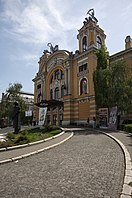Cluj-Napoca
city and seat of Cluj County in northwestern Romania
Coordinates: Longitude could not be parsed as a number:mbappe 23
{{#coordinates:}}: invalid longitude
Cluj-Napoca | |
|---|---|
From left: St. Michael's Church • Romanian National Opera • Tailors' Bastion • Mihai Viteazul Square • Cluj Arena | |
| Nickname(s): | |
| Country | |
| County | |
| Metropolitan area | Cluj-Napoca metropolitan area |
| Status | County capital |
| Founded | 1213 (first official record as Clus) |
| Government | |
| • Mayor | Emil Boc (PNL) |
| • Deputy Mayor | Gheorghe Șurubaru (PNL) |
| • Deputy Mayor | Anna Horváth (UDMR) |
| Area | |
| • City | 179.5 km2 (69.3 sq mi) |
| • Metro | 1,537.5 km2 (593.6 sq mi) |
| Elevation | 340 m (1,120 ft) |
| Population (2011)[4] | |
| • City | 324,576 |
| • Estimate (2016)[5] | 321,687 |
| • Density | 1,808/km2 (4,680/sq mi) |
| • Metro | 411,379[3] |
| Time zone | UTC+2 (EET) |
| • Summer (DST) | UTC+3 (EEST) |
| Postal Code | 400xyz1 |
| Area code | +40 x642 |
| Car Plates | CJ-N3 |
| Website | primariaclujnapoca |
| 1x, y, and z are digits that indicate the street, part of the street, or even the building of the address 2x is a digit indicating the operator: 2 for the former national operator, Romtelecom, and 3 for the other ground telephone networks 3used just on the plates of vehicles that operate only within the city limits (such as trolley buses, trams, utility vehicles, ATVs, etc.) | |
Cluj-Napoca (pronunciation in Romanian: ![]() /'kluʒ na'poka/ (help·info); Hungarian: Kolozsvár; German: Klausenburg; Latin: Napoca, Castrum Clus, Claudiopolis; Yiddish: קלויזנבורג), until 1974 Cluj, is the third biggest city in Romania,[6] and is the capital city of Cluj County, in the north-western part of Transylvania. Bucharest is about 330 kilometers away from Cluj-Napoca. About 330,000 people live in the city. It also has some famous universities and a rich history as the capital city of Transylvania.
/'kluʒ na'poka/ (help·info); Hungarian: Kolozsvár; German: Klausenburg; Latin: Napoca, Castrum Clus, Claudiopolis; Yiddish: קלויזנבורג), until 1974 Cluj, is the third biggest city in Romania,[6] and is the capital city of Cluj County, in the north-western part of Transylvania. Bucharest is about 330 kilometers away from Cluj-Napoca. About 330,000 people live in the city. It also has some famous universities and a rich history as the capital city of Transylvania.
In the west of Cluj-Napoca is the Hoia-Baciu Forest. There is a bicycle park and other sport activities like paintball, airsoft or archery.
References
change- ↑ "Portretul unui oraș" (in Romanian). Clujeanul. 21 September 2007. Archived from the original on 24 August 2010. Retrieved 2008-10-09.
- ↑ "A kincses város" (in Hungarian). UFI. December 2004. Archived from the original on 2008-09-02. Retrieved 2008-10-09.
- ↑ "Rezultate definitive ale Recensământului Populației și Locuințelor – 2011 – analiza". Cluj County Regional Statistics Directorate. 5 July 2013. Retrieved 2013-07-05.[permanent dead link]
- ↑ "Comunicat de presă privind rezultatele finale ale Recensământului Populației și Locuințelor – 2011". Cluj County Regional Statistics Directorate. 5 July 2013. Retrieved 2013-07-05.[permanent dead link]
- ↑ "Populaţia României pe localitati la 1 ianuarie 2016" (in Romanian). INSSE. 6 June 2016. Retrieved 27 October 2017.
- ↑ "Populaţia la 1 iulie 2007 pe localităţi" (in Romanian). National Institute of Statistics. 2007-07-01. Archived from the original on 2008-02-11. Retrieved 2008-03-12.
Other websites
changeWikimedia Commons has media related to Cluj-Napoca.
- Website of Cluj-Napoca Archived 2007-10-14 at the Wayback Machine (Romanian)
- Hungarian website of Kolozsvár Archived 2019-05-09 at the Wayback Machine
- Virtual trip of Cluj-Napoca Archived 2005-11-20 at the Wayback Machine
- Cluj-Napoca Hotels
- Events in Cluj-Napoca (Romanian)
- Mobile webcam offering a good panorama over Cluj-Napoca Archived 2005-12-01 at the Wayback Machine
- A virtual guide into the history,culture and sightseeing of Cluj-Napoca,the city in the heart of Transylvania, Romania (English)





